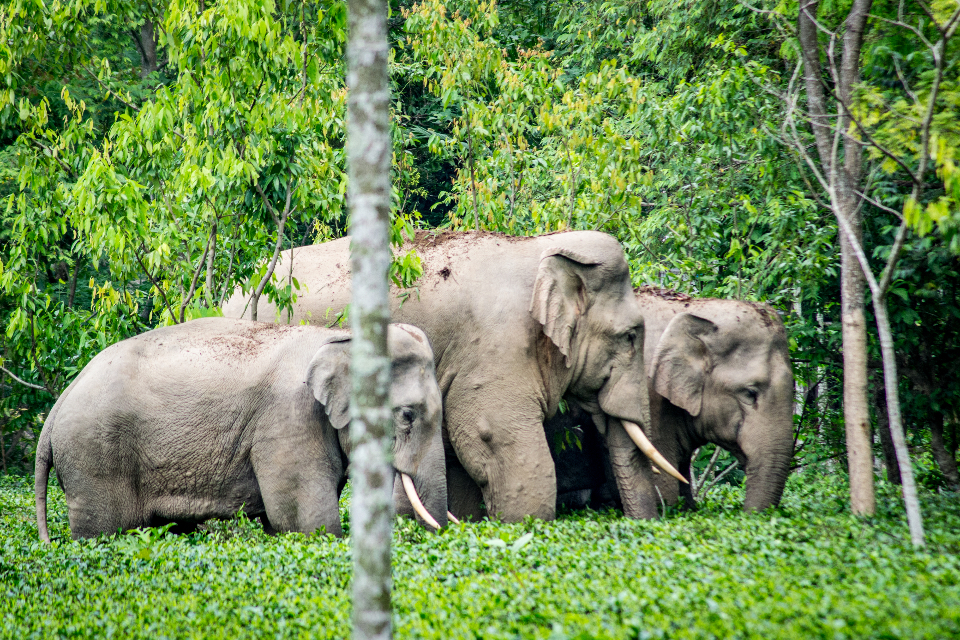The Big Bulls of Bardia
Nepal’s wild elephants once sparked speculation that they were descended from long-extinct mammothsNearly 30 years ago, three wild bull elephants, Raja Gaj, Kancha, and Thula Hatti, roamed boldly through the dense forests and grassy plains of Bardia and Suklaphanta in western Nepal. With their towering height and massive build, bull elephants have evolution on their side, traits that not only command attention but also boost their chances in the race to reproduce.
What truly set these Nepalese bull elephants apart from other Asian elephants, however, were their distinctive head domes and exceptionally powerful build. Raja Gaj, standing at an impressive 3.5m tall, was among the largest Asian bull elephants ever recorded.
Their massive body size and unusually high head domes caught the attention of elephant enthusiasts across the globe and sparked speculation: could these bulls be the last living links to the extinct elephant-like species: the Mammoth or the Stegodon?
In 1995, that curiosity turned into a quest. A team led by John Blashford-Snell of The Scientific Exploration Society in the UK, alongside the world-renowned paleontologist Adrian Lister, an expert on extinct proboscideans (the group that includes elephants and their long-gone relatives), embarked on a special expedition to Nepal to resolve this mystery. Venturing into the wilderness during the peak of the dry season, the expedition team tracked and studied these male elephants, along with other bulls like Bahadur Gajah, across the plains of Bardia.
Lister meticulously measured the body and head sizes of these wild bulls and compared them with those of wild elephants in Indian forests, ultimately debunking the myth that the Nepali bulls were related to mammoths or Stegodons. Instead, they were exceptionally large Asian elephants (Elephas maximus), and their remarkable size was simply a result of natural growth, and the abundant food and water found in Bardia’s thriving ecosystem.

But this exploration took a fascinating twist. Lister noticed something else that was remarkable about the skull shapes of Raja Gaj and Kancha: a high, domed forehead, strikingly similar to that of an extinct species, Elephas hysudricus, whose fossils have been discovered in the Siwalik Hills of northern India, considered a likely ancestor of today’s Asian elephants.
This similarity suggested that these Bardia bulls might still carry ancestral traits from a species that walked the Earth hundreds of thousands of years ago. Even more intriguing, the bulls looked noticeably different from male elephants in southern Indian forests, proving just how much geography and local environments can shape the bodies of wild animals.
The results were published in the Journal Elephant as a paper titled Exceptional Size and Form of Asian Elephants in Western Nepal in 2000.
Back in the 1990s, the story of Nepal’s giant elephants made headlines around the world. But today, with growing infrastructure and human development cutting across ancient migration routes and floodplains, we are left to wonder: how many more mega-bulls like Raja Gaj, Kancha and Thula hatti still roam the forests of Nepal—unseen and unstudied.
Marking a poignant end to the legend of Nepal’s most iconic wild male elephant, Raja Gaj was never spotted again after December 2007. He was believed to be around 70 years old at the time of his disappearance.
As conservation challenges mount and wild spaces shrink, the story of Nepal’s bull elephants is a powerful reminder of what still lies hidden in the natural world and how much we stand to lose if we stop paying attention.
Sanjeeta Sharma Pokharel is an elephant biologist and Assistant Professor at The Hakubi Center for Advanced Research and Graduate School of Asian and African Area Studies, Kyoto University.
Update: 20 June 2025
Call of the wild

Two wild elephants were found electrocuted to death in Sunsari and Jhapa in a single day earlier this week.
On Monday, a wild male elephant, estimated by officials to be around seven years of age, was found dead in a cornfield near the Kaushiki Community Forest in Sunsari’s Barahakshetra Municipality.
In Jhapa’s Mechinagar, a female wild elephant estimated to be 40 years old was found dead in a cornfield, also on Monday.
In February, a soldier stationed at Chitwan National Park shot a wild elephant to death allegedly after it charged at a patrol group attempting to coax it back into the forest.
Human-elephant contact has been increasing across communities near Nepal’s protected areas because the animals are not allowed to graze in the forests like they used to. Villagers also blame domesticated elephants for attracting wild ones. Communities in buffer zones have taken to setting up electric fencing to prevent elephants from getting into their fields.
More than 60 elephants have been killed, a significant number due to electrocution. On the other hand, 350 people are estimated to have lost their lives in elephant attacks over the past 24 years in Nepal.
Nepal’s Department of National Parks and Wildlife Conservation estimates up to 265 wild elephants (Elephas maximus) across Bardia National Park, Chitwan National Park, Koshi Tappu, Parsa, and Shukla Phanta National Park. An additional 150 elephants are domesticated.




